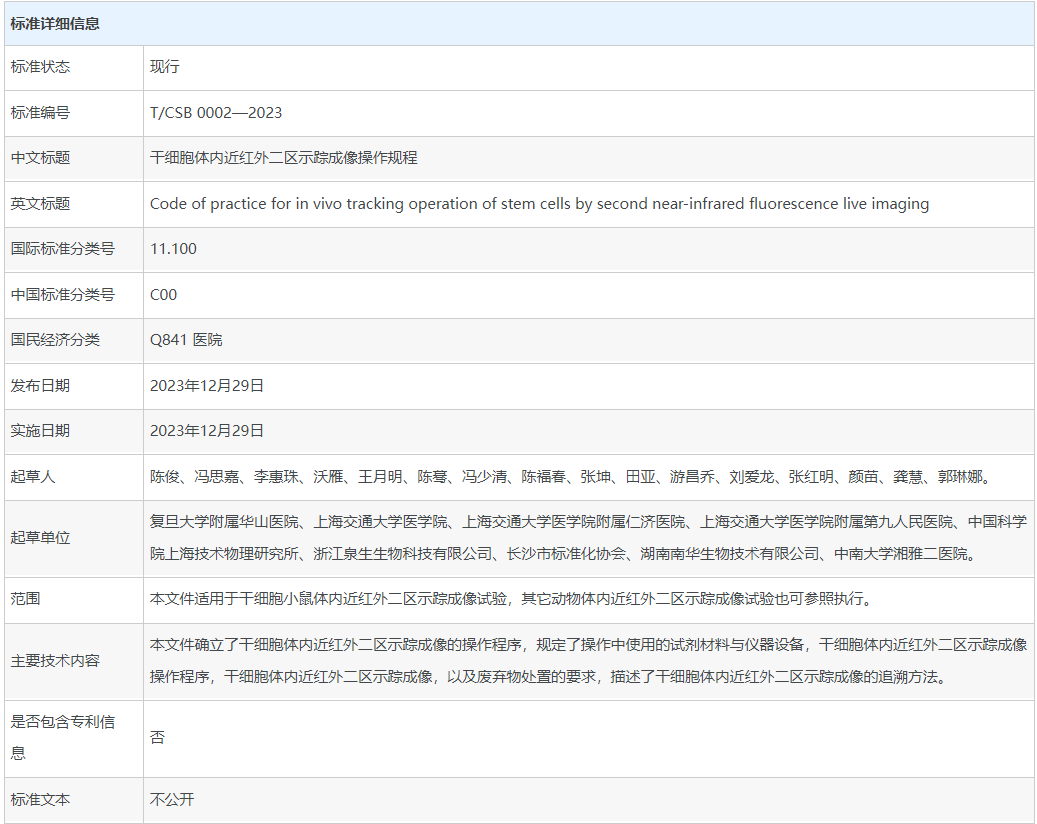The "Operating Procedures for in vivo Near Infrared Two Zone Tracing Imaging of Stem Cells - Team Standards" organized by Huashan Hospital affiliated with Fudan University and participated by Zhejiang Quansheng has been successfully published
Led by Huashan Hospital affiliated to Fudan University, and jointly participated by many institutions and units, such as Shanghai Jiaotong University School of Medicine, Renji Hospital of Shanghai Jiaotong University School of Medicine, the Ninth People's Hospital affiliated to Shanghai Jiaotong University School of Medicine, Shanghai Institute of Technical Physics of the Chinese Academy of Sciences, Zhejiang Quansheng Biotechnology Co., Ltd., Hillsi (Changsha) Institute of Science and Technology Co., Ltd., Hunan Nanhua Biotechnology Co., Ltd., Xiangya Second Hospital of Central South University, and approved by the Chinese Society of Biotechnology, on December 29, 2023 in the "National Group Standard Information Platform"( https://www.ttbz.org.cn/StandardManage/Detail/99857/ )The team standard "Operating Procedures for Near Infrared Two Zone Tracer Imaging in Stem Cells" (Standard No.: T/CSB 0002-2023) has been officially released. The cell and gene therapy (CGT) industry has become one of the most eye-catching fields both domestically and internationally in recent years. The scale of China's CGT industry has grown rapidly, with stem cells showing strong performance. In order to encourage scientific and standardized management of the research and production of cell therapy products, national, local, and relevant functional departments have successively issued and formulated policies such as the "14th Five Year Plan for Bioeconomic Development" and the "Healthy China 2030" Plan Outline, as well as a series of cell therapy product management measures such as the "Guidelines for Quality Control and Preclinical Research of Stem Cell Formulations (Trial)", "Management Measures for Clinical Research of Stem Cells (Trial)", and "Notice on Technical Guidelines for Research and Evaluation of Cell Therapy Products". The release of these new policies has raised higher technical requirements for the transformation and clinical application of stem cell products. Therefore, the industry should implement stricter quality management and risk control in the preparation and clinical research of stem cell preparations. The safety and efficacy of stem cells in vivo are key core parameters of stem cell products, but there is currently a lack of national and industry standards on how to objectively evaluate the safety and efficacy of stem cells in vivo. Therefore, the main purpose of formulating this standard is to utilize the advantages of near-infrared two zone imaging technology to achieve real-time dynamic monitoring at the live level, objectively evaluate the dynamic process of stem cell changes in small animals such as mice or rats through live animal models, and provide reliable data for the in vivo effectiveness and safety evaluation of stem cell therapy. The standard drafting team has undergone multiple rounds of expert review and revision, and finally formed the group standard "Operating Procedures for Near Infrared Two Zone Tracing Imaging in Stem Cells" (Standard No.: T/CSB 0002-2023). This standard can be applied to near-infrared two zone tracing imaging experiments in stem cell mice, establishing the operating procedures for near-infrared two zone tracing imaging in stem cells, specifying the reagent materials and instrument equipment used in the operation, as well as the composition of the operating procedures for near-infrared two zone tracing imaging in stem cells. The establishment of this standard not only marks another gratifying achievement of Zhejiang Quansheng in the subdivision field of stem cell research after obtaining four major clinical trial approvals for drugs, but also an important node for "industry university research" cooperation with top domestic clinical institutions, universities, and research institutes such as Huashan Hospital affiliated with Fudan University. In the future, Zhejiang Quansheng will continue to expand in the fields of cell therapy drugs and technologies such as mesenchymal stem cells, pluripotent induced stem cell derived cells, immune cells, etc., and cooperate with domestic and foreign institutions to continuously enhance the core technological competitiveness of the enterprise, thereby contributing its own strength to the development of the national CGT industry.
